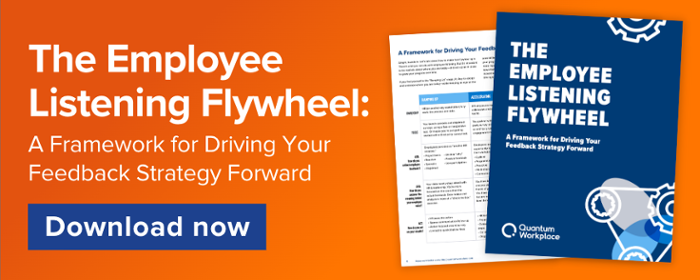Building Your Employee Listening Strategy: A Framework to Move You Forward
Employee listening is more than a survey. It’s your organization’s holistic approach to understanding, validating, and improving upon the employee experience. Sometimes we think we understand what concerns and motivates our workforce. But what we think doesn’t always align with reality.
An intentional employee listening strategy helps you uncover the true meaning behind your employee voice. It helps you confirm or dispel what you thought you knew, leveraging actionable data to drive improvements.
The need for effective employee listening is greater than ever. It’s imperative in helping you navigate the challenges, changes, and uncertainty that have become a constant in today’s business environment. Gathering employee feedback can help you discover truth, avoid speculation, and provide visibility into knowledge gaps. It provides the data you need to make informed, targeted decisions about your workforce and business.
In this article, we’ll cover everything you need to know about designing an employee listening framework for your organization.
The Employee Listening Flywheel
Think of employee listening like a flywheel that keeps turning.
A fine-tuned employee listening strategy will help you drive your business forward, becoming faster and stronger with each rotation of the wheel. As you continue to invest time and energy into your approach, you’ll build mounting momentum. A continuous cycle of feedback, insight, and action will take you farther than you thought you could go. You’ll find yourself looking back and thinking—why didn’t we do this sooner?!
|
Ask: Capture feedback from employees Aha: Analyze your data to determine priority “aha!” areas of improvement Act: Take what you learn to drive meaningful change Ask: Capture more feedback and measure your progress And the cycle continues! But how do you start to make the flywheel spin? Let’s dive in. |
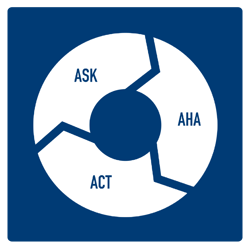
|
A Framework for Driving Your Feedback Strategy Forward
There’s a lot you can do with employee listening. But it’s important to be realistic about where you are today—and put a plan in place to grow your program over time.
If you find yourself in the “Ramping Up” stage, it’s key to accept and embrace where you are today—while keeping an eye on the possibilities of the future. First gear will keep you in motion, but your progress will be slow and limited. The more you put in, the more impact you’ll see. Your organization will be empowered to move faster and travel further. You’ll see bigger returns on your investments, and employee listening can truly become a lever for driving employee and business success
| RAMPING UP | ACCELERATING | CRUISING | |||||||
| OWNERSHIP |
HR (or another key stakeholder) fully owns the process and data. |
HR empowers managers to collaborate and converse with teams. |
HR is a driver and a coach. All levels of the organization are fully engaged in the process. |
||||||
| TOOLS |
You launch sporadic and disjointed surveys, using a free or inexpensive tool. Or maybe you’re just getting started with a third-party survey tool. |
You partner with a third- |
You’re leveraging sophisticated automation and system-driven insights. Your platform makes it easy to connect your listening data to your business data. |
||||||
|
ASK: How do you collect employee feedback? |
Employees perceive as “another HR initiative.”
|
Employees perceive as a prime opportunity to provide input on their workplace experience.
|
You’ve created a culture of feedback. Employees don’t wait
|
||||||
|
AHA: How do you uncover the meaning behind your employee voice? |
Your data mostly stays siloed with HR & leadership. You’re more focused on the score than the |
You have lots of actionable data and you work to get it in the hands of your managers quickly. You have some analysis chops but are mostly focused on high- level trends. |
You’re constantly analyzing and taking a more targeted approach. You slice and dice to get to the bottom of what is happening in various pockets of the organization. Your data is connected—across surveys, performance data, and business intelligence. |
||||||
|
ACT: How do you act on your results? |
|
|
|
Ramping Up
Many organizations start in the “Ramping Up” phase and build up from there. The best thing you can do for your organization is to get started—don’t look for perfection early on. Starting small can give you some of the building blocks you need to effectively scale your program.
Some characteristics of an early-stage employee listening program include:
- Fully owned by HR or another key stakeholder.
- Efforts are usually project based.
- Surveys are sporadic and survey tools are clunky.
- Survey results are held tightly.
- Action and communication are lightweight.
You’re Ready to Advance When:
- Your organization is looking to solve a key challenge like retention, hypergrowth, etc.
- It’s difficult to quickly gather employee feedback due to disparate systems or ownership
- You want to strategically layer in other types of surveys like exits or pulse surveys
- You want people leaders to have a more active role in understanding and acting on feedback
- You want your survey feedback to drive meaningful change in your organization
Accelerating
In the “Accelerating” phase, your commitment to employee listening becomes a continuous thread throughout your organization. You have created a strong foundation for capturing, understanding, and acting on employee feedback and use your engagement data to drive meaningful change.
Some characteristics of this phase include:
- Shared ownership across HR and management.
- Cyclical, proactive, and programmatic conversations.
- Partnership with a credible engagement survey vendor.
- Actionable data and reporting that is shared with managers.
- Collaborative action planning and ongoing conversations.
You’re ready to advance when:
- You want employee feedback to be embedded in your workplace culture at every level
- You want your listening strategy to be less programmatic, more continuous
- You need more sophisticated data and insights to drive smart decisions
- You want to start connecting your listening data to tangible business goals
Cruising
The “Cruising” stage is for organizations that are already committed to listening to their employees and are now embedding employee feedback into their operational culture. These organizations not only recognize the benefit of an advanced employee listening strategy, but they are dedicated to using that feedback to drive continuous improvements at every level of the organization.
At this level:
- You’ve created a “culture of us.”
- Tech drives powerful insights and action.
- Feedback is operationalized. Capturing feedback is no longer a program, but a way of life in your organization.
- You’re strategically uncovering meaning and taking targeted action.
- There’s a clear connection to business priorities.
It takes a lot of work to get to the “Cruising” stage. But it’s absolutely worth it. Companies who travel this far can build true cultures of employee success and make a clear connection between their investments, efforts, and business results.
How often should I send employee listening surveys?
There is a delicate balance between how often you send surveys and how engaged employees may be with those surveys. If you don’t send enough surveys, you’re missing out on opportunities to uncover key insights and trends and to act quickly.
But if you send too many surveys, your audience may feel disengaged and fatigued by so many requests.
We recommend that employees have at least four opportunities per year to share feedback via survey. Our research shows that employees who receive quarterly or monthly surveys are the most engaged. Four surveys per year is a good approach to balancing continuous feedback with visible and effective action.
Learn more about the ideal survey cadence here.
What is survey fatigue?
Survey fatigue is a phenomenon where employees become tired or disinterested in completing your surveys due to over-exposure or repetition. The biggest driver of survey fatigue is lack of action. If employees feel that you’re putting their feedback to good use (by seeing noticeable changes) they are less likely to experience survey fatigue.
The symptoms of survey fatigue include:
- Declining response rates.
- Lower quality responses, such as lack of supporting information or incomplete areas of the survey.
- Lack of engagement from participants, especially from groups of employees who have been historically engaged with your surveys.
The Three Types of Employee Listening Surveys
Now that you have an idea of which framework best suits your organization, and how often you should be collecting employee feedback, let’s talk about the types of surveys you can use to start your listening flywheel.
Surveys are an effective tool for listening to your employees. But not every survey is created equal.
How you design, deploy, and analyze your surveys will make or break the value of the insights you capture. There are three key pillars of your employee listening strategy: Engagement Surveys, Pulse Surveys, and Lifecycle Surveys.
| ENGAGEMENT SURVEYS | PULSE SURVEYS | LIFECYCLE SURVEYS | |
| Purpose |
Measure engagement at the company level |
Gain targeted insights on specific topics or demographics |
Understand employee trends at key employment milestones |
| Timing |
Annually |
As needed / Monthly |
At key milestones |
| No. Questions |
Less than 50 |
Less than 10 |
Less than 10 |
| Areas of focus |
Understand where your company excels and where you can improve. Give every employee a voice. |
Flexible, scalable surveys to ask about any topic, any time. Collect attributed or anonymous feedback on key areas. |
Capture unique insights and suggestions from new hires, tenured employees, and exiting employees about their experience and journey within your organization. |
1. Employee Listening: The Employee Engagement Survey
Employee engagement surveys are the foundation of your employee listening survey strategy. They provide the most widespread insight into your employee experience.
What is an employee engagement survey?
An employee engagement survey is designed to be sent annually and can help organizations measure employee engagement. A great employee engagement survey can help organizational leaders uncover employee perceptions, make them actionable, and implement changes that move the engagement needle.
Why should you use an employee engagement survey?
Employee engagement surveys provide a specific, measurable, and meaningful avenue to collect employee feedback at scale while also giving employees an outlet to voice their thoughts and feelings about their workplace experience.
Not to mention, employee engagement surveys are the best way to give a voice to every single employee.
There are a number of benefits to implementing an employee engagement survey:
- Get an accurate, holistic view of employee engagement within your organization.
- Compare and contrast among different employee groups.
- Determine commitment plans and next steps through data analysis.
- Save time and resources within your HR department.
- Build and maintain trust with your employees.
What type of questions should you ask on your employee engagement survey?
When designing your employee engagement survey for employee listening, we highly recommend you use the 6-Point Likert Scale.
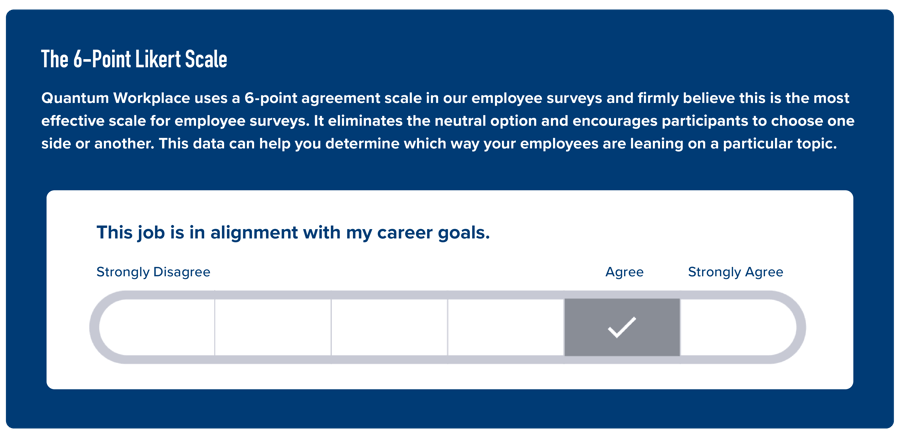
Scaled agreements are statements intended to elicit a favorable, neutral, or unfavorable response using a sliding scale. These types of questions have many benefits. They are easy to respond to and can provide meaningful metrics as to the intensity of opinions on a topic. Not to mention, they are easy to track over time and segment by category to create meaningful averages.
Quantum Workplace e9 Model of Engagement
Quantum Workplace has been helping organizations design, build, and scale their employee engagement surveys for more than 20 years. Our e9 Model of Employee Engagement is scientifically validated, highly researched, and highly effective in helping organizations understand, validate, and improve on employee engagement.
It’s important that you design your employee engagement survey using a reputable model that actually helps you measure and improve engagement. Otherwise, you might find yourself throwing spaghetti at the wall. It will be difficult to understand what truly matters and near impossible to drive meaningful change.
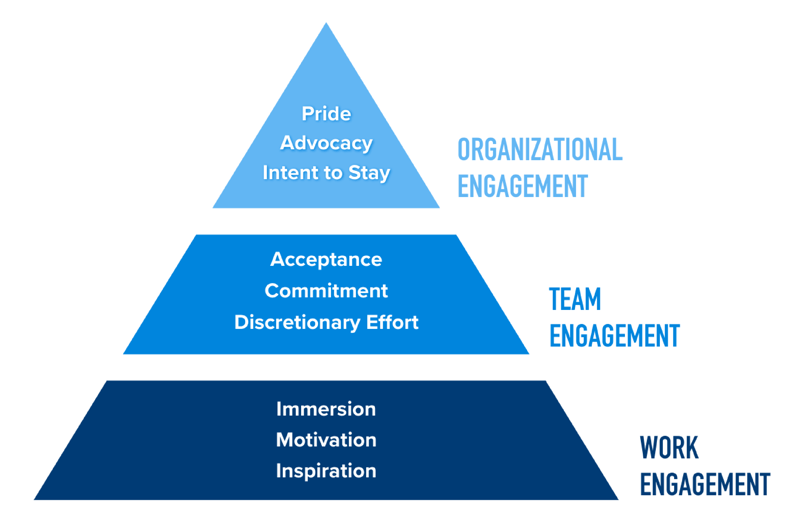
Engagement Outcome Items
Engagement outcomes are at the core of how we measure employee engagement. They help reveal the current state of employee engagement within organizations. Outcomes are not actionable because they are targets that organizations should strive to maintain or enhance. Our e9 model of employee engagement focuses on three factors, each containing three engagement outcomes.
- Work Engagement: How connected am I to my work?
- Team Engagement: How connected am I to my immediate coworkers?
- Organizational Engagement: How connected am I to the organization as a whole?
Engagement Impact Items
Engagement impact items help us figure out what can be done to positively influence employee engagement. They provide us with what actions can maintain or enhance those outcomes.
Examples of engagement impact items include:
- Career and Growth Development
- Communication & Resources
- Future Outlook
- Individual Needs
- Manager Effectiveness
- Team Dynamics
- Trust in Leadership
- Diversity and Inclusion
2. Employee Listening: The Pulse Survey
While engagement surveys provide your organization with a meaningful baseline of engagement, pulse surveys can take your listening strategy to the next level.
What is a Pulse Survey?
Pulse surveys are fast, easy-to-implement surveys that are specifically designed to rapidly and efficiently collect employee opinions. Pulse surveys make it easy to listen to your employees at scale at regular intervals or whenever you need to understand how a change is affecting your employee base.
Why Should You Use a Pulse Survey?
Pulse surveys can collect more targeted opinions and feedback from employees at a more frequent cadence than your engagement survey. Like the name implies, these surveys enable you to know the ‘pulse’ of your organization. Pulse surveys enable you to:
- Target a specific demographic or niche audience when you need to dig in on a specific topic or issue.
- Be both proactive or reactive, depending on what’s happening at your organization.
- Show employees that leadership cares about their needs and build trust.
- Provide an easy way for management to listen to their teams.
- Listen more carefully to critical areas identified in your engagement survey.
- Reinforce accountability for engagement survey follow up.
- Foster a culture that embraces continuous listening.
Pulse Survey Examples for Employee Listening
There are any number of reasons why your organization might want to send a pulse survey. The true benefit of pulse surveys comes from their flexibility. You can send pulse surveys to specific segments, a specific team, or a random subset of employees.
The topic of your pulse survey is also extremely flexible. Here are some great examples:
- Your engagement survey identified that employees want more flexibility. Your pulse survey can ask about what flexibility means to your employee base and how you might go about improving.
- Your company just went through a round of large layoffs. You want to make sure you collect employee thoughts, questions, and concerns in order to address them.
- A small group of employees attended a career growth training. You want to send a survey in order to identify the strengths and weaknesses of the training.
These are just a small sample of ways you can use pulse surveys to more effectively listen to your employees.
3. Employee Listening: Employee Lifecycle Surveys
Lifecycle surveys are similar to pulse surveys but have one key difference. These surveys are designed to collect feedback from employees at specific career milestones such as after 30 days of employment and when an employee exits the organization.
What is a Lifecycle Survey?
A lifecycle survey is designed to measure employee opinions at a specific point in their tenure of lifecycle. The most common lifecycle surveys used are new hire surveys, stay surveys, and exit surveys.
Why Should You Use a Lifecycle Survey?
Lifecycle surveys are unique because they offer your organization the opportunity to listen to employees during very specific milestones. These surveys not only allow you to set baselines, but also identify trends over time. Lifecycle surveys allow you to collect feedback about your onboarding process or identify when a particular issue is causing a large amount of exits from your company.
What Key Moments Should You Measure?
Lifecycle surveys are designed to capture milestone feedback. That means, your organization will likely ask for feedback during specific employee moments. While your organization may have a unique structure, you can usually include lifecycle surveys for:
- New hire feedback on days 30, 60, and 90.
- Stay surveys after 1, 3, 5, and 10 years of tenure with your company.
- Exit surveys on the employee’s last day for the employee leaving.
- Exit surveys on an employee’s last day for teammates of that employee.
Examples of Employee Lifecycle Topics and Questions
The topics you include during your lifecycle survey may look different depending on the milestone.
| NEW HIRE | STAY SURVEYS | EXIT SURVEYS |
|
|
|
How Turn Survey Results to Meaningful Action
So, you’ve collected your survey data. Now what? Traditional survey reporting is not enough. You need intelligent analysis and insights to make sense of your data and drive impact where it’s most critical to the business. Once you have your survey data collected in one place, you can start to analyze your survey results.
As we mentioned before, the different types of surveys we’ve covered offer unique value on their own. But when you can bring your data from various touchpoints TOGETHER, you’ll be able to create a more powerful, more holistic, and more actionable roadmap for improving your workplace.
The Steps to Analyze Your Engagement and Pulse Results
- Review your response rate: A good response rate is anywhere between 70-80% for large organizations (more than 500 employees) and 80-90% for smaller organizations (less than 500 employees).
- Evaluate favorability: Favorability is used to describe responses that are “Agree” and “Strongly Agree.” An overall favorability of 70% or higher is considered healthy. Use your favorability metrics to identify the largest areas for improvement.
- Identify high impact items: Your high impact items will be a summary of the areas where you’re doing really well and the areas which represent the largest opportunities for improvement.
- Choose your focus areas: If you’ve got a lot of work to do it can be difficult to choose where to focus. Our team recommends the 3-2-1 model. Find three key results within your data. These could be highs, lows, or key comments.
- Communicate progress: Regular communication is key to an effective employee listening strategy. You can’t just listen to your employees. You have to make sure they know they’re being heard.
Here’s an article where you can learn more about analyzing your survey results.
The Steps to Analyze Your Lifecycle Survey Results
- Understand perceptions: With new hire surveys, you should expect to see higher favorability on many topics compared to tenured employees thanks to the “honeymoon effect.” With exit surveys, keep a regular pulse on the reasons why employees are leaving. This will help you quickly identify and address barriers to retention.
- Look at trends over time: As more employees participate in your onboarding survey, your data will become more robust. Look at trends month-over-month or quarter-over-quarter to understand changes over time. It’s also helpful to look at your exit survey results month-over-month or quarter-over-quarter.
- Compare groups: Understand where you need to take action by investigating group or demographic trends in your onboarding data. Take a look at differences across location and department to see where you may need to standardize or improve your onboarding programs.
Bring Your Employee Listening Data Together
Each type of survey you conduct provides unique insight and value. Pooling the data from all of your surveys can provide an even more in-depth understanding of your employees’ perceptions and experiences.
Let's say your exit survey results reveal that the biggest reason employees leave your organization is a lack of career development opportunities. You’ve also learned from your engagement survey that career growth and employee development is a key driver of employee engagement in your organization.
To drill down even further, you learn in your engagement survey that your top performers have less favorable views on career growth and development opportunities than your average performers. You know your top performers are at a higher risk for leaving if you don’t do something about their career growth and development.
Maybe you’re also learning that a top reason candidates join your organization is the promise of career development opportunities. But your new hire survey tells you that new hires feel their jobs aren’t quite what they pictured—and they’re unclear on what opportunities for growth look like.
In this example, data from your exit and engagement surveys make it clear that solving for career development is critical. This issue is showing up early in the employee experience, in recruiting and onboarding.
Solving for this problem won't be easy, but feedback from across the employee lifecycle makes it clear that this is a business problem worth tackling.
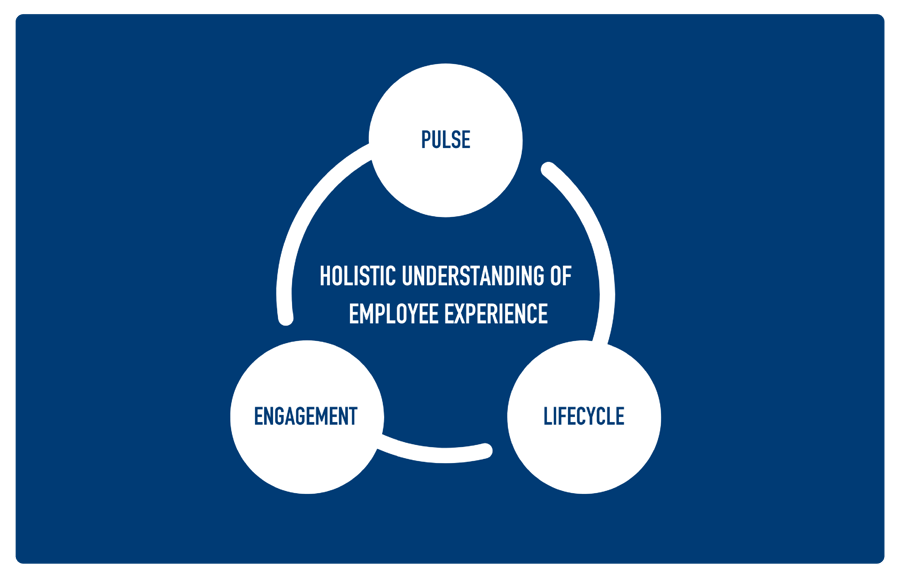
How to Choose the Right Employee Listening Survey Partner
It can be tempting to go off on your own when developing your survey listening framework. And if you’re at an early maturity level, doing something is always better than doing nothing.
The right survey partner can not only provide the survey framework you need to start building your listening program, but also provides you with the tools, data, analytics, reporting, and insights you need to impact what matters most to your employees.
When is a survey partner the right fit for you? There are several indicators that working with a survey partner is the right fit for your organization. Here are a few key indicators:
- You’ve outgrown free, inexpensive, or homegrown tools to collect employee feedback.
- You’ve had trouble getting a true measure of employee engagement
- You feel like you aren’t taking the right action at the right time—it’s hard to move the needle
- You’ve wasted valuable time and money on the wrong approach
- Thinking about building a survey strategy from scratch makes your head hurt
- You’re collecting data but aren’t sure what to do with it
- You’ve struggled to communicate the value of surveys to leadership
- You spent way too much time in spreadsheets trying to build ultimately clunky reports
You don’t have to do it alone. There’s a right way to survey your employees—and your survey technology plays a huge role in your success. With the right mindset, the right approach, and the right surveys and tools you can affect meaningful change at your organization.
You need a scientific approach to survey design that helps you ask, understand, and act on the right things. That starts with selecting the right survey partner.
Want to see Quantum’s employee listening software in action? Request a demo today.
Download an expanded PDF version of this guide
Want to keep learning? Download our complete guide to employee listening and have it sent directly to your inbox. The PDF gives you everything you need to start designing your employee listening framework including a complete list of survey questions, expert tips, and more.




